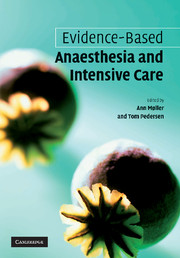Book contents
- Frontmatter
- Contents
- Foreword
- Contributors
- 1 Introducing evidence-based anaesthesia
- 2 How to define the questions
- 3 Developing a search strategy, locating studies and electronic databases
- 4 Retrieving the data
- 5 Critical appraisal and presentation of study details
- 6 Outcomes
- 7 The meta-analysis of a systematic review
- 8 Bias in systematic reviews: considerations when updating your knowledge
- 9 The Cochrane Collaboration and the Cochrane Anaesthesia Review Group
- 10 Integrating clinical practice and evidence: how to learn and teach evidence-based medicine
- 11 Involving patients and consumers in health care and decision-making processes: nothing about us without us
- 12 Evidence-based medicine in the Third World
- 13 Preoperative anaesthesia evaluation
- 14 Regional anaesthesia versus general anaesthesia
- 15 Fluid therapy
- 16 Antiemetics
- 17 Anaesthesia for day-case surgery
- 18 Obstetrical anaesthesia
- 19 Anaesthesia for major abdominal and urological surgery
- 20 Anaesthesia for paediatric surgery
- 21 Anaesthesia for eye, ENT and dental surgery
- 22 Anaesthesia for neurosurgery
- 23 Cardiothoracic anaesthesia and critical care
- 24 Postoperative pain therapy
- 25 Critical care medicine
- 26 Emergency medicine: cardiac arrest management, severe burns, near-drowning and multiple trauma
- Glossary of terms
- Index
13 - Preoperative anaesthesia evaluation
Published online by Cambridge University Press: 05 September 2009
- Frontmatter
- Contents
- Foreword
- Contributors
- 1 Introducing evidence-based anaesthesia
- 2 How to define the questions
- 3 Developing a search strategy, locating studies and electronic databases
- 4 Retrieving the data
- 5 Critical appraisal and presentation of study details
- 6 Outcomes
- 7 The meta-analysis of a systematic review
- 8 Bias in systematic reviews: considerations when updating your knowledge
- 9 The Cochrane Collaboration and the Cochrane Anaesthesia Review Group
- 10 Integrating clinical practice and evidence: how to learn and teach evidence-based medicine
- 11 Involving patients and consumers in health care and decision-making processes: nothing about us without us
- 12 Evidence-based medicine in the Third World
- 13 Preoperative anaesthesia evaluation
- 14 Regional anaesthesia versus general anaesthesia
- 15 Fluid therapy
- 16 Antiemetics
- 17 Anaesthesia for day-case surgery
- 18 Obstetrical anaesthesia
- 19 Anaesthesia for major abdominal and urological surgery
- 20 Anaesthesia for paediatric surgery
- 21 Anaesthesia for eye, ENT and dental surgery
- 22 Anaesthesia for neurosurgery
- 23 Cardiothoracic anaesthesia and critical care
- 24 Postoperative pain therapy
- 25 Critical care medicine
- 26 Emergency medicine: cardiac arrest management, severe burns, near-drowning and multiple trauma
- Glossary of terms
- Index
Summary
Preoperative assessment encompasses surgical and anaesthesia evaluation, preoperative testing, patients' preparation for surgery and obtaining informed consent. It is an everyday routine for anaesthesiologists, and sometimes it is taken as a boring and time-consuming chore, but it is vital for safe and appropriate patients' perioperative care. Scope of the present paper is to review available evidence on anaesthesia preoperative evaluation (who, when and how to conduct it) and its relevance to clinical practice, together with indications for future research.
Introduction
Preoperative assessment is a large and complex process, which includes multiple professional involvements: nursing, anaesthesiology, different surgical specialties, laboratory medicine, at times cardiology, pulmonology, radiology, and others. This results in a very large production of scientific literature (approximately 5000 papers over the past 10 years) [1]: unfortunately, from such a vast knowledge base very little evidence is available, leaving professionals with a large portion of uncertainty, even if we will limit to the anaesthesia preoperative evaluation for elective procedures, defined as “the process of clinical assessment that precedes the delivery of anaesthesia care for surgery and for non-surgical procedures” [2].
The intent of the present paper is not to be another systematic review of original research, but its scope is to present a summary of published evidence-based literature (systematic reviews, meta-analyses, clinical practice guidelines, health technology assessments) on the subject, which have been revised using the same methodology of the AGREE instrument [3].
Keywords
- Type
- Chapter
- Information
- Evidence-based Anaesthesia and Intensive Care , pp. 127 - 134Publisher: Cambridge University PressPrint publication year: 2006

